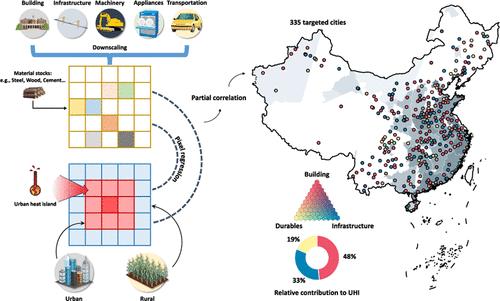当前位置:
X-MOL 学术
›
Environ. Sci. Technol.
›
论文详情
Our official English website, www.x-mol.net, welcomes your
feedback! (Note: you will need to create a separate account there.)
Uncovering the Nexus between Urban Heat Islands and Material Stocks of Built Environment in 335 Chinese Cities
Environmental Science & Technology ( IF 10.8 ) Pub Date : 2024-07-25 , DOI: 10.1021/acs.est.4c04739 Jian Sun 1, 2 , Zezhuang Liu 2 , Fan Xia 2 , Tao Wang 3, 4, 5 , Nanxi Jiang 2, 6, 7 , Yehua Chen 2, 8 , Feidan Meng 1 , Sha Lu 3 , Yilu Gu 2 , Xining Yang 9, 10 , Chunbo Zhang 10, 11 , Xiaofeng Gao 2
Environmental Science & Technology ( IF 10.8 ) Pub Date : 2024-07-25 , DOI: 10.1021/acs.est.4c04739 Jian Sun 1, 2 , Zezhuang Liu 2 , Fan Xia 2 , Tao Wang 3, 4, 5 , Nanxi Jiang 2, 6, 7 , Yehua Chen 2, 8 , Feidan Meng 1 , Sha Lu 3 , Yilu Gu 2 , Xining Yang 9, 10 , Chunbo Zhang 10, 11 , Xiaofeng Gao 2
Affiliation

|
China’s unprecedented rapid urbanization has dramatically reshaped the urban built environment, disrupting the thermal balance of cities. This disruption causes the urban heat island (UHI) effect, adversely affecting urban sustainability and public health. Although studies have highlighted the remarkable impacts of the built environment on UHIs, the specific effects of its various structures and components remain unclear. In this study, a multidimensional remote sensing data set was used to quantify the atmospheric UHIs across 335 Chinese cities from 1980 to 2020. In conjunction with stocks of three end-use sectors and three material groups, the impacts of gridded material stocks on UHI variations were analyzed. The findings reveal that building stocks exert a predominant influence in 48% of cities. Additionally, the extensive use of metal and inorganic materials has increased thermal stress in 220 cities, leading to an average UHI increase of 0.54 °C. The effect of organic materials, primarily arising from mobile heat sources, is continuously increasing. Overall, this study elucidates the effect of the functional structure and material composition of urban landscapes on UHIs, highlighting the complexities associated with the influence of the built environment on the urban heat load.
更新日期:2024-07-25











































 京公网安备 11010802027423号
京公网安备 11010802027423号